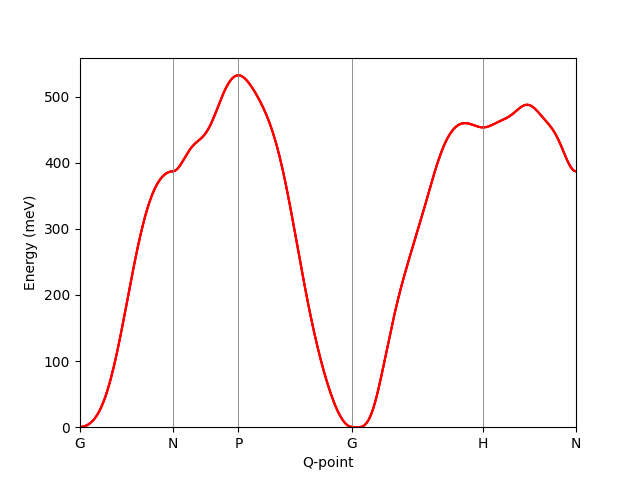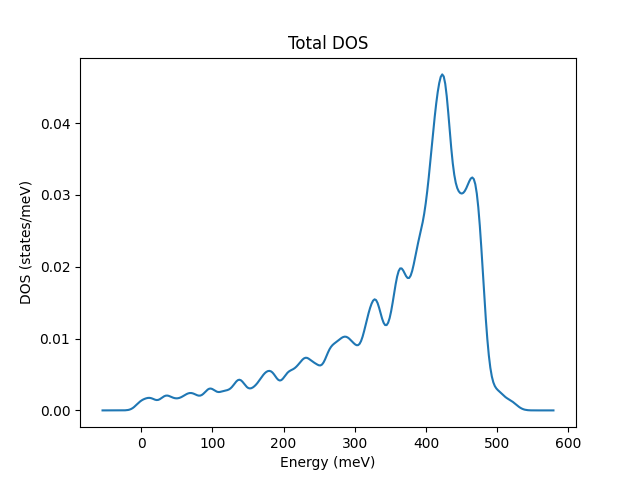Magnon band structure from TB2J output
In this section we show an application of calculating the magnon band structure using the TB2J results.
There is a script within the TB2J package: TB2J_magnon.py, which can be used to plot the magnon band structure. We can show its usage by:
TB2J_magnon.py --help
usage: TB2J_magnon.py [-h] [--fname FNAME] [--qpath QPATH] [--figfname FIGFNAME] [--show]
TB2J_magnon: Plot magnon band structure from the TB2J magnetic interaction parameters
optional arguments:
-h, --help show this help message and exit
--fname FNAME exchange xml file name. default: exchange.xml
--qpath QPATH The names of special q-points. If not given, the path will be automatically choosen. See https://wiki.fysik.dtu.dk/ase/ase/dft/kpoints.html for the table of special kpoints and the default path.
--figfname FIGFNAME The file name of the figure. It should be e.g. png, pdf or other types of files which could be generated by matplotlib.
--show whether to show magnon band structure.
The input file specified to the –fname parameter is by default exchange.xml file, which is the output in the Multibinit xml format, as can be found in the TB2J_results/Multibinit directory.
Here we take the BCC Fe as an example. After we have the TB2J_results directory, we can go to the Multibinit directory and find the exchange.xml file. The q-path can be generated automatically from the atomic structure information, using the [ASE][https://wiki.fysik.dtu.dk/ase/ase] library. We need to specify a path of q-points if the default is not what we want. The default k-path and the labels of the special kpoints can be found at this page. For example, we want a path of “Gamma-N-P-Gamma-H-N” instead of the default, it can be given by:
TB2J_magnon.py --qpath GNPGHN --figfname magnon.png --show
The magnon band structure is then written to a By using the –show parameter, the band structure is shown on screen.

exchange_magnon
From version v0.7.5, the infomation for plotting the band structure is written into a json file(magnon_band.json), together with the script for parsing the file and plot the band structure (plot_magnon_from_json_file.py).
From version v0.7.7, there is a script to plot the magnon density of states.
TB2J_magnon_dos.py --help
usage: TB2J_magnon_dos.py [-h] [-p PATH] [-n NPOINTS] [-w WINDOW WINDOW] [-k KMESH KMESH KMESH]
[-s SMEARING_WIDTH] [-g] [-Jq] [--show] [-f FIG_FILENAME] [-t TXT_FILENAME]
Plot magnon DOS
options:
-h, --help show this help message and exit
-p PATH, --path PATH path to exchange.xml
-n NPOINTS, --npoints NPOINTS
number of points in the energy
-w WINDOW WINDOW, --window WINDOW WINDOW
energy window for the dos, two numbers giving the lower and upper bound
-k KMESH KMESH KMESH, --kmesh KMESH KMESH KMESH
k mesh
-s SMEARING_WIDTH, --smearing_width SMEARING_WIDTH
Gauss smearing width in meV. Default is 10 meV.
-g, --gamma gamma centered k mesh
-Jq use Jq
--show show the figure
-f FIG_FILENAME, --fig_filename FIG_FILENAME
output filename for figure.
-t TXT_FILENAME, --txt_filename TXT_FILENAME
output filename of the data for the magnon DOS. Default: magnon_dos.txt
For example, with the following command, we get the DOS for bcc Fe.
TB2J_magnon_dos.py --show -s 10 -k 25 25 25 -f magnon_dos.png --show

magnon_dos
The energies and the DOS are also saved to a txt file specified. The two columns of the file are the energies, and the DOS, respectively. It can be used for plotting the DOS if you want to plot in your own style.